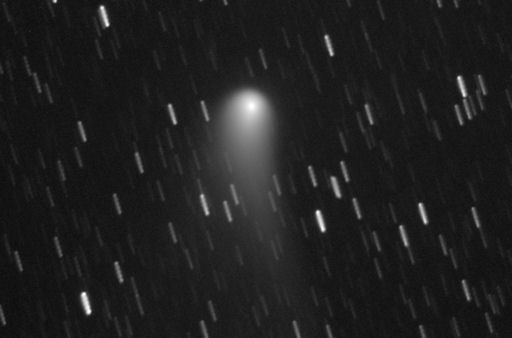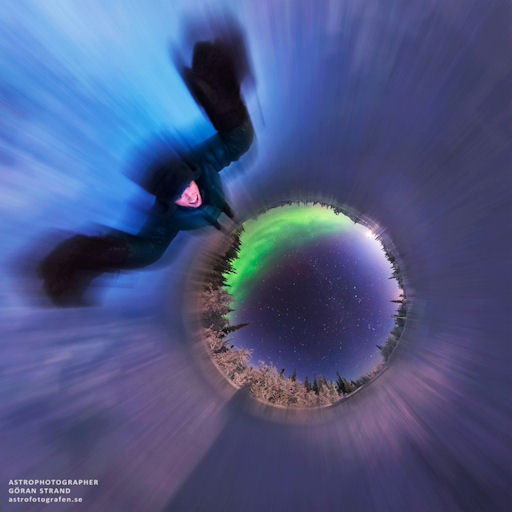QUIET SUNSPOTS: There are four sunspots visible on the Earthside of the sun. None of them is actively flaring. NOAA forecasters put the odds of an M-class solar flare today at no more than 5%. Solar flare alerts: text, voice.
INCOMING COMET: In little more than a month, Comet PanSTARRS will cross the orbit of Mercury and probably brighten to naked-eye visibility as it absorbs the heat of the nearby sun. Sky watchers around the world will be looking for it in the sunset skies of early March, when it passes closest to the sun and to Earth. Until then a telescope is required; here is the view last night through a 0.3-meter-diameter reflector in Argentina:
A team of astronomers led by Martin Masek took the picture using the remotely-controlled F(/Ph)otometric Robotic Atmospheric Monitor--"FRAM" for short. "The stars are trailed in this 9x120s exposure, which tracked the comet," explains Masel.
Currently, the comet ranks about 8th magnitude, dimmer than the human eye can see, but it could brighten 100-fold on March 10th when it makes its closest approach to the sun (0.3 AU). The latest curves suggest that PanSTARRS will emerge glowing about as brightly as a 3rd magnitude star, similar to the stars in the Big Dipper.
There might, however, be surprises in store. Comet PanSTARRS has never been to inner solar system before. It is falling in from the Oort cloud, a great swarm of comets beyond Neptune and Pluto unaltered by the warmth of the sun. When Comet PanSTARRS dips it toe inside the orbit of Mercury for the first time, almost anything could happen ranging from an anticlimatic "bake-out" to a spectacular disruption. Stay tuned for updates. [3D Orbit]
FALLING FOR AURORAS: A stream of solar wind flowing from a coronal hole is expected to hit Earth's magnetic field on Jan. 25-27. In response, NOAA forecasters estimate a 25% to 40% chance of polar geomagnetic storms. High-latitude aky watchers should be alert for auroras in the nights ahead. Aurora alerts: text, voice.
Warning: Solar wind can affect your equilibrium. Photographer Göran Strand of Kall, Åre, Sweden, documented the effect in this composition he calls Falling for Auroras:
"I assembled this 360-degree image from photos I took during an aurora display on Jan. 17th," says Strand. "The joy of seeing an aurora dancing in the sky is the same joyful feeling as sledding down a slope."

![]()
Solar wind
speed: 384.2 km/sec
density: 10.8 protons/cm3
explanation | more data
Updated: Today at 1827 UT
![]()
X-ray Solar Flares
6-hr max: B2 1311 UT Jan25
24-hr: B3 0127 UT Jan25
explanation | more data
Updated: Today at: 1800 UT
![]()
![]()
![]()
Daily Sun: 25 Jan 13
![]()
![]()
None of these sunspots is actively flaring. Credit: SDO/HMI
![]()
![]()
![]()
Sunspot number: 60
What is the sunspot number?
Updated 24 Jan 2013
Spotless Days
Current Stretch: 0 days
2013 total: 0 days (0%)
2012 total: 0 days (0%)
2011 total: 2 days (<1%)
2010 total: 51 days (14%)
2009 total: 260 days (71%)
Since 2004: 821 days
Typical Solar Min: 486 days
Update 24 Jan 2013
The Radio Sun
10.7 cm flux: 103 sfu
explanation | more data
Updated 24 Jan 2013
![]()
![]()
![]()
Current Auroral Oval:
![]()
Switch to: Europe, USA, New Zealand, Antarctica
Credit: NOAA/POES
![]()
![]()
![]()
Planetary K-index
Now: Kp= 2 quiet
24-hr max: Kp= 2 quiet
explanation | more data
![]()
Interplanetary Mag. Field
Btotal: 15.5 nT
Bz: 11.3 nT north
explanation | more data
Updated: Today at 1827 UT
![]()
![]()
![]()
Coronal Holes: 25 Jan 13
![]()
![]()
Solar wind flowing from this southern coronal hole should reach Earth on Jan. 26-27. Credit: SDO/AIA.






